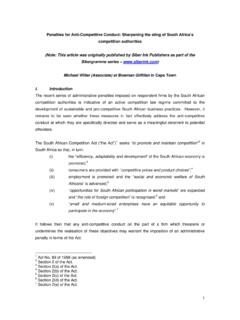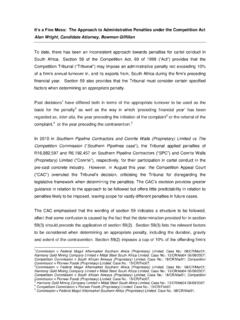Transcription of Australian Government - iasc.gov.au
1 Determination: The route: The applicant: Public Register File: Australian Government International Air Services Commission DETERMINATION [2012] IASC 106 south Africa Qantas Airways Limited (ACN 009 661 901) (Qantas) IASC/APP/201215 The IASC has decided to grant Qantas' application for an allocation of per week on the south Africa route. The detennination is for five years from the date that Qantas' existing detenninations on the route are revoked. south african Airways is authorised to code share on Qantas' flights operated to and from south Africa until 31 2014, subject to conditions. 1 The application and submissions Qantas applied to the Commission on 4 July 2012 for a new determination under section 7 ofthe International Air Services Act 1992 (the Act) allocating it seven frequencies per week in each direction between Australia and south Africa.
2 This will replace existing determinations [2008] IASC 105, [2008] IASC 109, [2009] IASC 126, [2010] IASC 115 and [2012] IASC 103 (the existing determinations). Qantas has requested the new determination for a five year term, expiring five years from the date the determination is made. Qantas has stated that if it is allocated the capacity it is requesting, it will seek revocation under Section 27 AA of the Act of the existing determinations which currently allocate to it seven frequencies per week on the south Africa It will request that the commencement date of the new allocation be the date of the revocation of the existing determinations. Qantas has requested that the new determination contain a condition under section 15(2)(e) of the Act to allow south african Airways (SAA) to code share on Qantas operated flights between Australia and south Africa until 31 March 2016.
3 Qantas provided the Commission with a public and a confidential version of its application, with commercially sensitive information redacted from the public version. Qantas maintains that the application for the allocation of capacity meets the paragraph 4 criteria in the International Air Services Policy Statement dated 19 May 2004 (the Policy Statement) and the remainder of its application addresses its request for code sharing. 1 Throughout, references to the south Africa route or to the route mean to the Australia- south Africa route as a whole, including indirect services by third country carriers, unless otherwise stated. The direct Sydney-Johannesburg and Perth-Johannesburg routes are referred to as the Sydney and Perth routes respectively. 62 Northboume Avenue Canberra City ACT Australia Postal: GPO Box 630 Canberra ACT 2601 Australia Qantas says that the route is long, thin and isolated, requiring large aircraft with little flexibility to adjust to changes in demand.
4 Qantas says that without the code share neither party would be able to maintain the current number of frequencies in the medium to long term. Qantas says that the code share is a reciprocal hard block arrangement under which the marketing carrier is exposed to losses if pre-purchased seats are not sold. Qantas submits that it does not set a ''price floor" under fares by charging SAA a high price for the seat blocks, saying that the method it uses to price the blocks is exactly the same as it uses to estimate and manage its own costs. Qantas claims that there is fair competition between the two airlines, particularly for business passengers. According to Qantas, third country carriers provide a real competitive alternative, particularly out of cities other than Sydney and Perth. Absent the code share, Qantas considers it extremely unlikely that a new airline would enter the route with direct services, or that Virgin Australia would re-enter the route.
5 Qantas says that approval of the code share to 2016 will assist it and SAA commit to further investment on the route and that Qantas is more likely to deploy refurbished B747's on the route if the code share continues. On 5 July 2012, the Commission published the Qantas application and a notice inviting other applications for the capacity and submissions from interested parties. Submissions were received from SAA (a public and a confidential version), an interested member of the public and the Australian Competition and Consumer Commission (ACCC). The Commission has considered all of these submissions and will refer to them where relevant. All non-confidential material supplied by the applicant and submitters is filed on the Register of Public Documents and is available on the Commission's website ( ). The confidential versions of the Qantas and SAA submissions are filed on the Commission's confidential register.
6 1. 9 The Commission has analysed a considerable amount of data to assess the likely public benefit from the code share. The data includes information held by Government agencies such as the Australian Bureau of Statistics (ABS) and the Bureau of Infrastructure, Transport and Regional Economics (BITRE); commercial-in-confidence material provided by Qantas; data on fares on the Australia- south Africa route provided by Qantas; and fare information available on on-line web sites. Also, on 10 August 2012, the Commission had a teleconference discussion with its economic consultant, Dr Chris Pleatsikas, on economic principles relevant to its assessment of the code share application. Dr Pleatsikas also provided written comments on Qantas' submission in response to the Draft Determination. Dr Pleatsikas' comments were provided to Qantas and are available on the Commission's website.
7 2 The Draft Determination The Commission issued Draft Determination [20 12] IASC 1 06d on 14 September 2012. In its Draft Determination the Commission proposed to allocate Qantas seven services per week on the south Africa route for five years from the date that Qantas' existing determinations on the route are revoked. The Commission proposed to include a condition in [2012] IASC 106 Page2of25 its determination authorising SAA to code share on Qantas' flights operated to and from south Africa until 31 December 2014. In the Draft Determination, the IASC explained its reasons for limiting the term of authorisation for the code share arrangement. The Commission accepted that there are likely to be marginal public benefits gained from approving the code share for the next two years. However, the Commission indicated that it is not satisfied that the code share would be of benefit to the public beyond 2014.
8 After 2014 the Commission considers there is a greater prospect of two carriers competing directly on one or both of the Sydney and Perth routes, or possibly on another city pair. In a situation where it may be economic for two carriers to operate competing services on direct routes, the Commission is of the view that the code share arrangement could hinder rather than promote competition by deterring or delaying the introduction of competing services and increasing barriers to entry. Submissions on the Draft Determination were invited and received from an interested member of the public and from Qantas. The interested member of the public says that the IASC has failed to act in the best interest of the public, and as a result the public will be subject to a monopolistic arrangement that will cost them tens of millions of dollars over the next two years and possibly longer.
9 Qantas' submission is available on the IASC website. In short, Qantas accepts the terms ofthe Draft Determination which authorises the code share to 31 December 2014. Qantas also submits that: It is important to have a "home carrier" at each end of the route and absent the code share, it would be difficult to maintain current demand on the route. Expected future growth in market demand does not mean that there is a greater prospect of two carriers offering direct parallel services. Qantas and SAA engage in vigorous competition on the route. Hard block capacity is charged out to the marketing carrier on a straight cost pass through basis. Therefore, the costs that the marketing carrier contributes to are the same costs that it would incur if it operated its own flight on the route. This permits the two carriers to compete as though they both operated smaller aircraft.
10 There are substantial (not marginal) public benefits arising from approving the code share until the end of2014. 3 Requirements under the Act and the Policy Statement Qantas has applied for a determination under section 7 ofthe Act for an allocation of capacity on the route and for a condition in the determination under section 15(2)( e) to allow SAA to code share on Qantas operated flights on the route until31 March 2016. Under section 7 a determination must not allocate available capacity unless the Commission is satisfied that the allocation would be of benefit to the public. In assessing the benefit to the public, the Commission must apply the criteria set out for that purpose in the policy statement made by the Minister under section 11. [2012] IASC 106 Page3of25 Under paragraph 4 of the Policy Statement, the use of entitlements by Australian carriers under a bilateral arrangement is of benefit to the public if such carriers are reasonably capable of obtaining the necessary approvals to operate on the route and are reasonably capable of implementing their applications.









